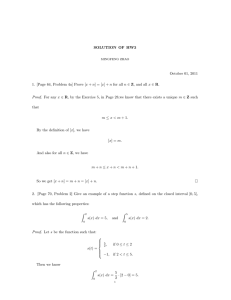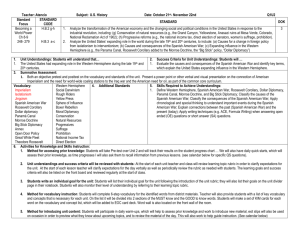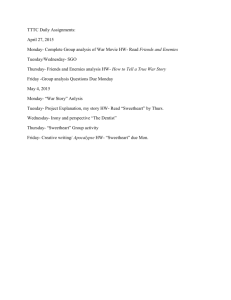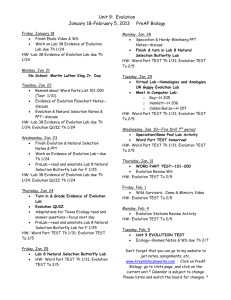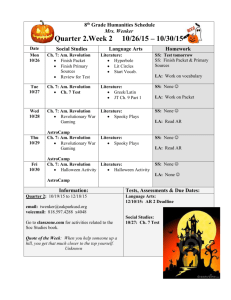Unit Plan Industrialism
advertisement
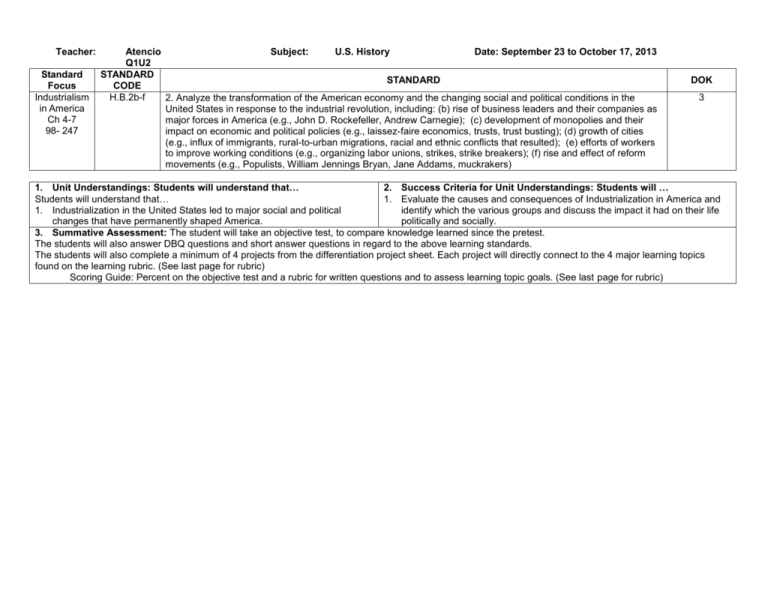
Teacher: Standard Focus Industrialism in America Ch 4-7 98- 247 Atencio Subject: U.S. History Date: September 23 to October 17, 2013 Q1U2 STANDARD STANDARD CODE H.B.2b-f 2. Analyze the transformation of the American economy and the changing social and political conditions in the United States in response to the industrial revolution, including: (b) rise of business leaders and their companies as major forces in America (e.g., John D. Rockefeller, Andrew Carnegie); (c) development of monopolies and their impact on economic and political policies (e.g., laissez-faire economics, trusts, trust busting); (d) growth of cities (e.g., influx of immigrants, rural-to-urban migrations, racial and ethnic conflicts that resulted); (e) efforts of workers to improve working conditions (e.g., organizing labor unions, strikes, strike breakers); (f) rise and effect of reform movements (e.g., Populists, William Jennings Bryan, Jane Addams, muckrakers) DOK 3 1. Unit Understandings: Students will understand that… 2. Success Criteria for Unit Understandings: Students will … Students will understand that… 1. Evaluate the causes and consequences of Industrialization in America and 1. Industrialization in the United States led to major social and political identify which the various groups and discuss the impact it had on their life changes that have permanently shaped America. politically and socially. 3. Summative Assessment: The student will take an objective test, to compare knowledge learned since the pretest. The students will also answer DBQ questions and short answer questions in regard to the above learning standards. The students will also complete a minimum of 4 projects from the differentiation project sheet. Each project will directly connect to the 4 major learning topics found on the learning rubric. (See last page for rubric) Scoring Guide: Percent on the objective test and a rubric for written questions and to assess learning topic goals. (See last page for rubric) 1. Vocabulary: Industrialization Urbanization Nativism Entrepreneur Laissez faire Patent Bessemer process Mass production Corporation Monopoly Trust Andrew Carnegie John D Rockefellar Consumer Culture Trust Busting Immigrants Rural to urban migration Labor union Strikes Strike breakers Populists William Jennings Bryan Jane Addams Muckrakers Conservation Sweat shop Collective bargining Samuel Gompers Haymarket Riot Pullman Strike Americanization Suburb Tenement Gilded Age Vaudville Assimilation Spoils System 19th Amendment 4. Additional Standards 5. Skills Required to Achieve Understandings: 1. Define industrialization and urbanization; Explain the various reasons for the industrial revolution; Classify the consequences of the industrial revolution on society, politics, and economic policies; Apply chronological and spatial thinking to understand important events during the industrial revolution; Explain connections between the past and the present (today); Apply writing techniques (e.g. ACE, Formula Writing) when answering open ended (OE) questions or short answer (SA) questions. 6. Activities for Knowledge and Skills Instruction: 1. Method for accessing prior knowledge: Students will take Pre-test over Unit 2 and will track their results on the student progress chart … We will also have daily quick starts, which will assess their prior knowledge about reconstruction and the lesson for each day, as time progresses I will also ask them to recall information from previous lessons. (see calendar below for specific QS questions). 2. Unit understandings and success criteria will be reviewed with students: At the start of each unit teacher and class will review learning topic rubric in order to clarify expectations for the unit. At the start of each lesson teacher will clarify expectations for the day verbally as well as periodically review the rubric as needed with students. The learning goals and success criteria will also be listed on the front board and reviewed regularly at the start of class. 3. Students write an individual goal for the unit: Students will list their individual goal for the unit following the introduction of the unit rubric; they will also list their goals on the unit divider page in their notebook. Students will also monitor their level of understanding by referring to their learning topic rubric. 4. Method for vocabulary instruction: Students will complete 6-step vocabulary for the identified words from district materials. Teacher will also provide students with a list of key vocabulary and concepts that is necessary for each unit. On the list it will be divided into 2 sections of the MUST know and the GOOD to know words. Students will make a set of KIM cards for each word on the vocabulary and concept list, which will be added to EOC card deck. Word wall is also located on the front wall of the room. 5. Method for introducing unit content: Students will participate in daily warm-ups, which will help to assess prior knowledge and work to introduce new material, exit slips will also be used on occasion in order to preview what they know about upcoming topics, and to review the material of the day. This will also work to help guide instruction. (see calendar below for more details) 7. Teaching/Modeling Activities, Guided Practice Activities, Independent Practice Activities, Methods for checking understanding: (Students are to work in homogenous groups for the unit) September 23 September 24 September 25 September 26 September 27 Students will review and Students will work in groups Students will participate in a Students will work on their Students will watch a video preview unit. in order to complete a guided mini discussion over the industrialism internet that demonstrates what life QS- What is the industrial note organizer. industrial revolution. assignments in their groups. was like during this time revolution? QS- What definition term QS- What is a robber baron QS- Why did the industrial period. 1. Students got assigned to refers to the growth of a city and give 2 examples? revolution change society so QS- List 3 inventions and their or area. 1. Class will have a small much? their inventors from the new partner groups. Part 1 Starts mini discussion over the 1. Students are to work in Industrial Revolution. 2. Students were reminded to Have students follow part 1 industrial revolution cooperative groups and 1. We will watch a short re-take/take unit 1 test. checklist self paced hitting key points from the complete DBQ mini video that shows what life 3. I collected U1 quick starts. groups…. organizer. Following assignments see class was like during the 4. Papers from unit 1 were 1. Students will use discussions students will website. industrial revolution. passed out to students resources on the website create a concept quilt as HW- work on mini 2. Class will have a and graded during vocab. in order to complete the a class. assignments discussion on the film 5. Students then listed their “Industrial Age Guided 2. Following the discussion and students will identify unit two learning Note Sheet”. and class quilt students characteristics from the topics/goals 2. Make sure to look at a can finish their note guide time period. 6. Student groups worked on variety of sources and if needed or move on to HW- finish anything that is completing 6-step add extra notes as the next section. incomplete vocabulary for the 3 unit needed. HW-NA words. HW- Work on note guide and HW- Finish vocabulary terms turn in when complete September 30 Students will review material using a concept quilt. QS- What were the living conditions like in the city? 1. Students will continue working or finish the internet assignments above 2. If completed students will move on to next step. HW- Start menu item 1 October 1 Students will complete an individual menu item to show understanding for topics QS- What is a monopoly? 1. Students are to choose one item from menu 1 and complete. See website for options. 2. Small group instruction HW_-work on menu item October 2 Students will complete an individual menu item to show understanding for topics QS- Define Nativism 1. Students are to choose one item from menu 1 and complete. See website for options. 2. Finish menu item 3. Part 1 ends October 7 Students will will examine the causes and consequences of the Industrial Revolution QS- How has the Industrial Revolution shaped America? 1. Watch the Flocabulary video and add details to your practice essay from the 3rd. 2. Review Family History Activity. HW- start your family history October 14 Students will use their resources from the entire unit and answer big topic essay. QS- Summarize the Industrial Revolution listing 5 major facts. 1. Answer big topic question using student Resources. 2. Students should complete unit 2 cards. 3. Make sure notebook is in order they will be graded on Thurs. HW- finish note cards and organize notebook. October 8 Students will Students will complete an individual menu item to show understanding for learning topic. QS- What is the difference in immigration and migration? 1. Students are to choose one item from menu 2 & 3 and complete. HW- Finish menu item if not completed yet October 9 Students will review the causes and consequences of the Industrial Revolution. QS- Get started on work. 1. Follow the questions prompts and answer on a separate sheet of paper. Make sure to use complete sentences and restate. Please label each section on your paper. HW- Finish at home October 16 Students will take a midterm in cooperative groups. 1. Chart midterm progress on class charts. 2. Review Expectations for the test 3. Take midterm 4. Work on something from another class or read a book Review Questions HW- NA October 15 Students will take a unit test to measure their progress. QS- Get out your study guide and quietly review by yourself or with a partner. 1. Review Expectations for the test, collect cards 2. Take unit test 3. Work on something from another class or read a book Review Questions HW- NA October 3 Students will check their level of understanding of the IR QS- Describe the Industrial Revolution. 1. Teach students test taking strategy 2. Have students take quiz 3. Grade the quizzes as a class and collect. Exit Slip- Define Industrial Revolution. HW- Continue working on missing work… October 10 Students will view the causes and consequences of the Industrial Revolution. QS- Get started on work 1. Follow the questions prompts and answer on a separate sheet of paper. Make sure to use complete sentences and restate. Please label each section on your paper. HW- Finish at home October 17-----------------1/2 Day 9 Weeks Rewards Day 1. Depending on student progress they will either participate in rewards day or work on make up items in the classroom. 2. Need 70% or higher in class and less than 3 tardies for the quarter. October 4 Students will take notes from lecture. QS- What is migration? 1. Lecture over immigration –take notes on the presentation. 2. Following the lecture we will discuss the key points of the lecture… 3. Watch video over immigration. HW- continue working on missing assignments. October 11 Students will create unit review cards to study for their test. QS- Define Industrial Revolution. 1. Make review cards for Unit 2 2. Play Review games for Unit 2 Test 3. Make sure notebook is in order HW- finish cards, organize notebook, and finish work October 18 No School Professional Development Day 8. Feedback Is given to students through daily warm-ups which will either preview or review key concepts. Students will also get written or oral feedback on papers or assignments and are highly encouraged to re-do or revise their work. Grades are promptly put into the grade book and students are encouraged to take advantage or the “re-do” window. I have created an email listserv and reminders and announcements are sent out weekly to students and parents. If student are in need of help they can see me before school during lunch or after school. Students are also given student and teacher example of what is expected for their work, and behavior. 9. Reflection (Write reflection on unit and results.) (Have students write a reflection of what they learned at end of unit) 10. Review (Items to include in next unit – based on assessment results)
